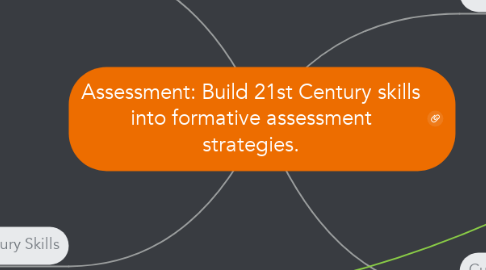Assessment: Build 21st Century skills into formative assessment strategies.
by Josh Thomas


1. Assessment
1.1. Professional Development: Strategies and reasons for assessing.
1.2. Incorporate Project-Based Learning pedagogy
1.3. Collaborate with institutions that already implement effective assessment practices and rubrics
1.3.1. Edutopia
1.3.2. BIE
1.3.3. Area Districts
1.3.3.1. PD Observation Days
1.3.3.2. Collaborative Meetings
1.3.3.3. Critical Friends Protocol
2. 21st Century Skills
2.1. Critical thinking
2.1.1. Defined
2.2. Communication
2.3. Collaboration
2.4. Creativity
2.5. Evaluation of 21st Century Skills
2.5.1. Team Grade/Accountability
2.5.2. Evaluate through summative presentations of learning
2.5.3. Curriculum that challenges students to make connections and be responsive
2.5.4. Rubrics
2.5.4.1. Qualitative and Quantitative
2.5.4.2. Specific Actions Outlined
2.5.4.3. Research-Based
3. Implementation
3.1. Establish 21st Century skills to be assessed
3.2. Create/refine working definition of 21st Century Skills to be assessed
3.2.1. Educator Voice and Choice
3.3. Equip instructors with appropriate assessment strategies and models
3.4. PD: Provide instructors clear purpose for assessment
3.5. Develop Rubrics to guide assessment of 21st Century skills
3.5.1. Teacher rubrics
3.5.2. Student self-assessment rubrics
3.6. Assess effectiveness, study data/results, act on results to improve implementation and growth (PDSA)
4. Culture
4.1. Staff must have Buy-In to the importance of 21st Century skills and realize the need and urgency.
4.1.1. Cite research
4.1.2. PD
4.1.2.1. Inservice
4.1.2.2. Conferences
4.2. Provide tools necessary
4.2.1. Rubrics
4.2.2. PD:Training
4.2.3. Technology
4.2.4. Rubrics
4.2.5. Pedagogies

